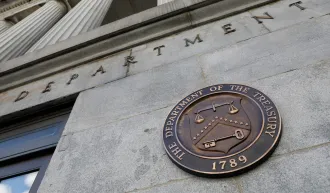Peter Koudijs: Risk Analysis or Risk Paralysis?
A lesson on post-crisis financial stress disorder from 18th century Amsterdam.
December 02, 2013

Tulips bloom in front of U.S. Treasury Building in Washington (Reuters photo by Jim Young)
It was a confident, high-powered investment firm with credit lines at top financial institutions. It made big bets using borrowed money to buy assets and generate higher returns. But when the market for those assets went south, lenders demanded more collateral until the firm suddenly collapsed. Many frightened lenders clamped down on all borrowers, setting off an overall credit crunch.
The implosion of a giant subprime mortgage lender in 2007? The collapse of Lehman Brothers in 2008?
No. This crisis hit Amsterdam in 1772, after a respected Dutch investment syndicate made a disastrous bet on shares of the British East India Company.
A new paper on the Dutch debacle, coauthored by Peter Koudijs at Stanford Graduate School of Business, turns up modern-day lessons about the not-so-scientific ways in which personal experience rather than market information can determine optimism, pessimism, and access to credit.
It’s no surprise that credit is “pro-cyclical.” When asset prices are booming, optimistic lenders tend to make more loans and often feed the euphoria. When markets sink, lenders rein in risk and sometimes make the downturn worse.
But what drives the underlying optimism or pessimism? Koudijs, working with Hans-Joachim Voth at the Universitat Pompeu Fabra in Barcelona, found surprising answers.
Though the Dutch financial markets then had none of today’s technology, they employed many of the same practices that traders use today. Investors bought securities, sometimes borrowing money with loans secured by the shares they were buying. In today’s language, they bought shares on margin. Lenders protected themselves by demanding a “haircut” ― collateral in cash or securities that exceeded the loan amount by a specified percentage. If the value of the securities dropped below that specified percentage, the lender would demand that the investor put up additional money to stay in line with the haircut. If the investor couldn’t come up with the added margin, the lender was entitled to liquidate the securities and recoup the loan amount.
The Amsterdam crisis began when a Dutch group known as the Seppenwolde syndicate made a big, contrarian bet on the shares of East India Company. Those shares had plunged in 1771 mainly because of losses in Bengal, but the company kept paying high dividends and covered up its shortfalls by borrowing money. Convinced that East India shares would quickly rebound, the Seppenwolde group aggressively bought them on margin. But instead of rebounding, the shares fell even further after the company slashed its dividend.
To make a long story short, the Seppenwolde group went bankrupt shortly after Christmas of 1772. The disaster was a top story in Dutch newspapers. It ruined some of Amsterdam’s merchants and bankers. To prevent a general credit collapse, the city of Amsterdam stepped in temporarily as a lender of last resort. Sound familiar?
As it happened, the lenders to Seppenwolde never lost a guilder. Within weeks, they had liquidated all the East India shares and had recovered the money they had loaned.
But then the story took a strange turn. Koudijs and Voth found that Dutch lenders reacted to the Seppenwolde collapse in strikingly different ways. Those who had made loans to Seppenwolde but hadn’t actually lost money became far more pessimistic and demanded much bigger haircuts from all new borrowers. But those who had dodged the bullet by not lending to Seppenwolde didn’t tighten their requirements at all. In fact, those lenders slightly reduced haircuts to their borrowers ― a sign they were at least as sanguine as before.
Why the difference? It wasn’t because of a difference in the available information. As Koudijs and Voth point out, everybody in Dutch financial circles knew and understood the magnitude of what had happened. Nor was it because the Seppenwolde lenders had to rebuild their own finances. Within weeks of the default, the lenders knew they hadn’t lost any money.
Yet, the disparity in haircuts lasted for almost two years. In fact, the pessimism and risk-aversion of the Seppenwolde lenders reduced the overall availability of leverage in Amsterdam.
In a rigorous analysis of Dutch financial records, Koudijs and Voth conclude that the only real difference between the pessimists and the optimists was whether they had gone through a harrowing personal experience. Koudijs compares it to the behavior of people who lived through the Great Depression, and who avoided financial risk for decades after trauma had passed.
The Dutch case involved sophisticated financial professionals, people accustomed to analyzing financial and economic trends. Yet, they too focused on their personal experience.
“It suggests that people put more weight on what happened to themselves and less weight on other information that might be available,” Koudijs says. The more personally removed people are from an important event, the less it is to affect their appetite for risk.
It’s not clear which group of Dutch lenders was wrong. It’s possible that the Seppenwolde lenders ignored the evidence about broader financial conditions and were too pessimistic. It’s also possible that the other lenders were too casual in brushing off the implications of the East India mess. Either way, the Dutch episode suggests that even sophisticated investors become optimistic or pessimistic for myopic reasons.
To Koudijs, this has important regulatory implications for heading off 21st-century bubbles and busts.
“If lenders are too optimistic during market booms and too pessimistic in downturns, that could be a good reason for authorities to set conservative capital requirements,” he suggests. “Higher haircuts might dampen the initial run-ups, but they could also dampen the subsequent fallouts when tides turn.”
Peter Koudijs is an assistant professor of finance at Stanford Graduate School of Business.
For media inquiries, visit the Newsroom.
Explore More

How To: Reject Pitches Like a Venture Capitalist

Big Investors Say They Use ESG to Reduce Risk (But Mostly Focus on the E and G)



